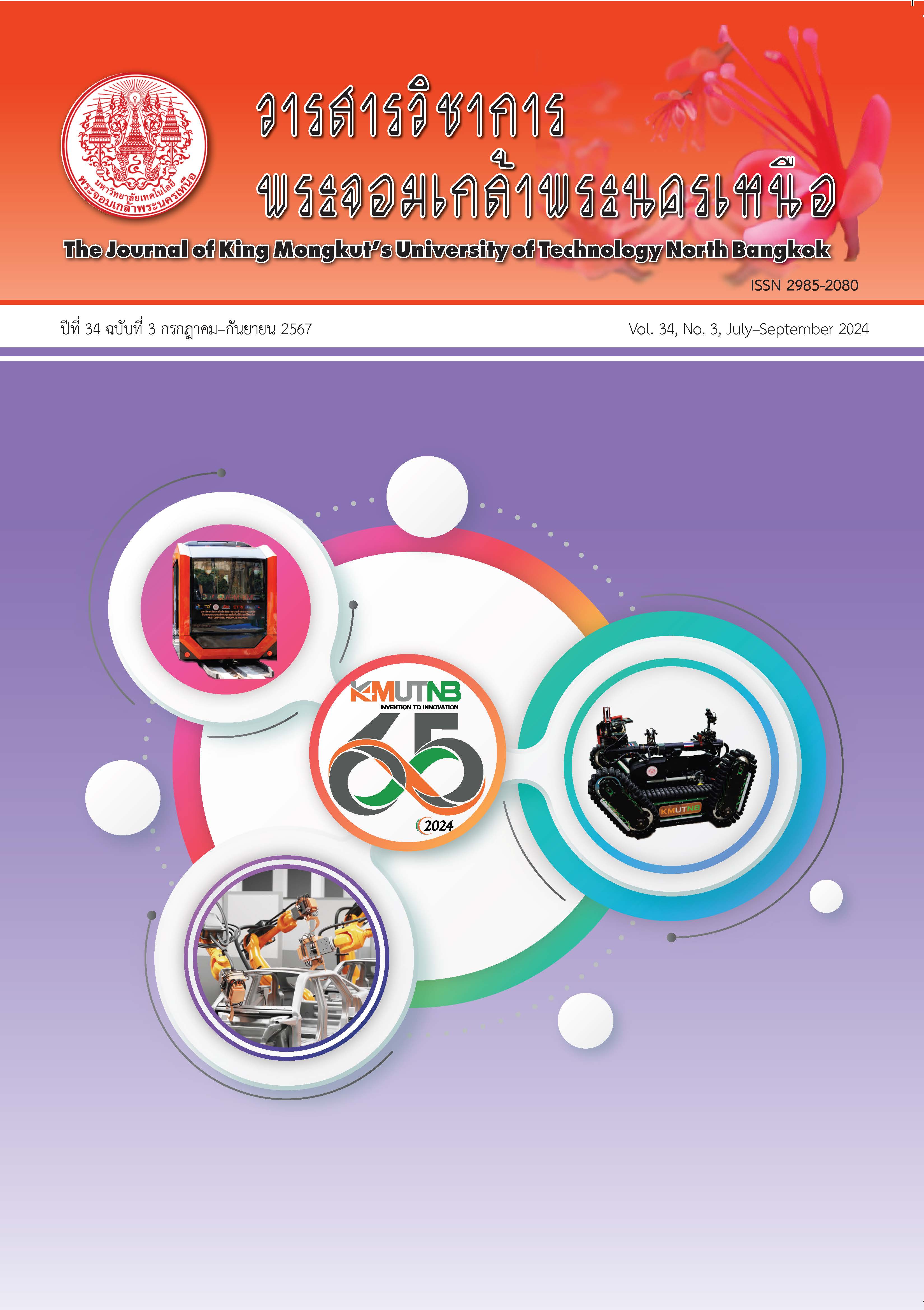แบบจำลองการวิเคราะห์ความเสี่ยงของการเกิดภาวะซึมเศร้าโดยใช้เทคนิคการเรียนรู้ของเครื่อง
Main Article Content
บทคัดย่อ
ภาวะโรคซึมเศร้าเป็นหนึ่งในสาเหตุหลักที่ก่อให้เกิดปัญหาการฆ่าตัวตาย โดยผู้ป่วยเป็นโรคซึมเศร้าส่วนใหญ่ไม่ทราบว่า ตนเองเกิดภาวะซึมเศร้าและมักแสดงออกผ่านทางสื่อสังคมออนไลน์ผ่านข้อความหรือรูปภาพ เนื่องจากสื่อสังคมออนไลน์เป็นรูปแบบการสื่อสารผ่านช่องทางที่ไม่ต้องอาศัยการแสดงออกทางสีหน้า นอกจากนี้งานวิจัยที่มีอยู่เน้นไปที่การใช้ข้อความในเครือข่ายสังคมออนไลน์มาวิเคราะห์เพียงอย่างเดียว งานวิจัยนี้จึงนำเสนอแบบจำลองการวิเคราะห์ความเสี่ยงของการเกิดภาวะซึมเศร้าโดยใช้เทคนิคการเรียนรู้ของเครื่อง โดยใช้ข้อมูลจากการทำแบบประเมินภาวะซึมเศร้า 9 คำถาม และจากผู้ใช้งานทวิตเตอร์ จำนวน 405 คน ร่วมกับเทคนิคการเรียนรู้ของเครื่องประกอบด้วย เทคนิคนาอีฟเบย์ เทคนิคซัพพอร์ตเวกเตอร์แมชชีน เทคนิคต้นไม้การตัดสินใจ เทคนิคเพอร์เซ็ปตรอนหลายชั้น และเทคนิคการสุ่มป่าไม้ ผลการทดลองพบว่า แบบจำลองการวิเคราะห์ความเสี่ยงของการเกิดภาวะซึมเศร้าด้วยเทคนิคการสุ่มป่าไม้ให้ค่าประสิทธิภาพโดยรวมสูงที่สุด คือร้อยละ 87.39 ในขณะที่ผลการเปรียบเทียบประสิทธิภาพของแบบจำลองจากการใช้ตัวแปรนำเข้าที่แตกต่างกันพบว่า การใช้คุณลักษณะจากทวิตเตอร์ทั้งประเภทข้อความและรูปภาพให้ค่าประสิทธิภาพโดยรวมสูงที่สุด นอกจากนี้ การหาคุณลักษณะที่สำคัญพบว่า คุณลักษณะที่สำคัญที่สุดในการวิเคราะห์ความเสี่ยงภาวะซึมเศร้า คือ ค่าเฉลี่ยคะแนนความรู้สึกซึ่งเป็นคุณลักษณะของทวิตเตอร์ประเภทข้อความ
Article Details

อนุญาตภายใต้เงื่อนไข Creative Commons Attribution-NonCommercial-NoDerivatives 4.0 International License.
บทความที่ลงตีพิมพ์เป็นข้อคิดเห็นของผู้เขียนเท่านั้น
ผู้เขียนจะต้องเป็นผู้รับผิดชอบต่อผลทางกฎหมายใดๆ ที่อาจเกิดขึ้นจากบทความนั้น
เอกสารอ้างอิง
The Excellence Center for Depression Disorder, Knowledge and essence about depression, World Health Day 2017. Depression: Let's talk, 2017, pp 1–2.
PUEY UNGPHAKORN Institute for Economic Research. (2021, May). Mental health problems in Thailand during the Covid-19 crisis from the perspective of an economist. [Online]. (in Thai). Available: https://www.pier.or.th/ abridged/2021/08/
Department of mental health, “Strategic Plan for the Department of Mental Health during the 12th National Economic and Social Development Plan (2017–2021),” Mental Health Strategy Department of Mental Health, 2021, pp 19–20.
Institute for population and social research Mahidol University, Thai health report 2560. Bangkok: Amarin Printing & Publishing Public Company Limited, 2017, pp 88–89 (in Thai).
K. Phanichsiri and B. Tuntasood, “Social media addiction and attention deficit and hyperactivity symptoms in high school students in bangkok,” Journal of the Psychiatrist Association of Thailand, vol. 61, no. 3, pp. 191–2004, 2016 (in Thai).
M. Aldarwish and H. Ahmad, “Predicting depression levels using social media posts,” in IEEE 13th International Symposium on Autonomous Decentralized System (ISADS), Bangkok, Thailand, 2017, pp. 277–280.
M. Choudhury, S. Counts and E. Horvitz, “Social media as a measurement tool of depression in populations,” in Proceedings of the 5th Annual ACM Web Science Conference (WebSci '13), New York, USA: ACM, 2013, pp. 47–56.
P. Vateekul and T. Koomsubha, “A study of sentiment analysis using deep learning techniques on Thai Twitter data,” in Proceeding of 2016 13th International Joint Conference on Computer Science and Software Engineering (JCSSE), 2016, pp 1–6.
M. Park, C. Cha and M. Cha, “Depressive moods of users portrayed in Twitter,” In Proceedings of the ACM SIGKDD Workshop on Healthcare Informatics (HI-KDD). , SIGKDD, 2012, pp. 1-8.
A.G. Reece and C.M. Danforth, “Instagram photos reveal predictive markers of depression,” EPJ Data Science, vol. 6, no. 15, pp. 1–12. 2017.
Department of mental health. (2018). Patient Health Questionnaire-9 (9Q). [Online]. (in Thai). Available: https://www.dmh.go.th/test/ download/files/2Q%209Q%208Q%20(1).pdf
A. Esuli and F. Sebastiani, “SENTIWORDNET: A publicly available lexical resource for opinion mining,” in Proceedings of LREC-06, the 5th Conference on Language Resources, 2006, pp. 417–422.
S. Baccianella, A. Esuli, and F. Sebastiani, “ S e n t i w o r d n e t 3 . 0 : a n e n h a n c e d lexical resource forsentiment analysis and opinion mining,” in Proceedings of the Seventh International Conference on Language Resources and Evaluation (LREC'10), 2010, pp. 2200–2204.
C. Musto, G. Semeraro and M. Polignano, “A comparison of Lexicon-based approaches for Sentiment Analysis of microblog posts,” in CEUR Workshop Proceedings, 2014, 1314, pp. 59–68.
V. A. Rao, K. Anuranjana, and R. Mamidi, “A SentiWordNet strategy for curriculum learning in sentiment analysis,” eprint arXiv, 2005.04749, 2020.
S. Tipprasert. (2022). Depression dataset. [Online]. (in Thai). Available: https://www. twothai.com/dep/.
P. Viola and M. Jones, (2001). “Rapid object detection using a Boosted cascade of simple features,” in Proceedings of the IEEE conference on computer vision and pattern Recognition, 2001, pp. 1–9.
L. Wilms and D. Oberfeld, “Color and emotion: effects of hue, saturation, and brightness,” Psychological Research, vol. 82, pp. 896–914, 2018.
P. Sanguansat. Artificial Intelligence with Machine Learning, Digital Technology. 1st ed. Nonthaburi: IDC Premier, 2019 (in Thai).
A. G. Reece, A. J. Reagan, K. L. M. Lix, P. S. Dodds, C.M. Danforth and E.J. Langer, “Forecasting the onset and course of mental illness with Twitter data,” Scientific Reports 7, pp. 13006, 2017.
M. F. Kabir, C. M. Rahman, A. Hossain and K. Dahal, “Enhanced classification accuracy on naive bayes data mining models,” International Journal of Computer Applications, vol. 28, no. 3, pp 9–16. 2011.

